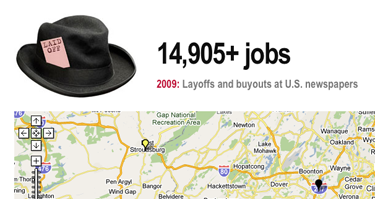
Detail from a screen capture from Paper Cuts, a blog that is tracking newspaper layoffs. The shrinking newspaper labor force stresses the production of quality journalism.
Shrinking ranks of staff journalists and a growing pool of freelancers pose ethical problems both for the rights and safety of reporters and for the quality and accountability of news.
For those interested in keeping visual track of this transformation, there’s a map of the layoff landscape you may not have been aware of. Blogger Alan Mutter linked to the website mapping news layoffs across the country in a December 1 post. The project is called Paper Cuts, and provides an interesting visual to go along with the ethical questions Mutter and others raise about a changing news landscape.
The running tally on the site was at 14,905 layoffs as of December 16th. According to the site, Paper Cuts’ creator, Erica Smith, often updates the map daily or even twice daily.
In his post on layoffs, Mutter writes “Absent some miracle that motivates someone, anyone, to start fairly compensating journalists again, we are going to lose something that has been very important to our democracy throughout the life of the nation. I can’t imagine what it will be like without professional journalists, but I don’t think we will like the outcome.”
Staff jobs in a newsroom alongside seasoned writers provide mentoring and education to young writers that working on the web or freelancing does not, so it’s reasonable to expect that reduction in entry-level staffers now may mean fewer quality journalists later. Moreover, with a larger and larger proportion of former staff writers forced into freelancing or out of journalism altogether, the ethical issues facing freelancers also spread. StinkyJournalism recently covered the story of one freelance writer’s injury in Afghanistan and subsequent battle with Smithsonian magazine over compensation for his injuries.
Mutter calls the elimination of full-time professional journalism jobs over the last few years “so relentless that it has become remarkably, depressingly commonplace.” And this sense of relentlessness becomes much more visceral surfing through the Paper Cuts map.
Layoffs and buyouts are color-coded by number of people from 1-24 to 100+. The map gives a sense of the concentration of job losses across space, and you can zoom in to get more information about each data point for the details a long view lacks. Unfortunately, the tally doesn’t offer much solace or answers to the more detailed issues Mutter brings up about how problems young journalists face in this market may affect future news coverage, or how it looks like the ranks of top women editors are thinning as the industry shrinks. But it does provide a clear visual context for those questions.
And for anyone looking for an accurate, data-driven representation of how bad things are and how they are evolving, check out Paper Cuts.






